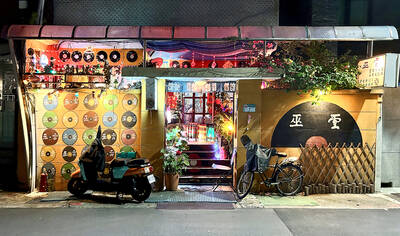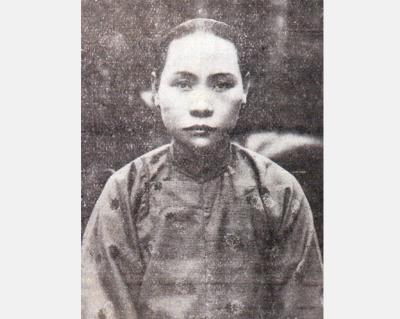A crowd of foreign students gathered on the spacious veranda of the Big Teapot restaurant (大茶壺) in Taipei’s Maokong scenic and tea cultivating area. They had been brought there as part of a tightly packed itinerary in which they were eating their way around Taiwan as part of their studies at the University of Gastronomic Science.
Their meal at the Big Teapot focused on tea cuisine, tea production being a specialty of the Maokong area. Staff at the Big Teapot enthusiastically introduced the many innovative dishes incorporating local tea the restaurant had developed, ranging from a topping of deep-fried tea leaves to a tea popsicle.
The next 10 days would be filled with similar visits during which the students tasted local cuisine and learn about the ingredients from which they are made. The itinerary incorporated everything from small farms trying to capitalize on a growing appeal for natural cultivation and hand processing of foodstuffs to farmers associations working on ways to improve direct marketing to the consumer.
The University of Gastronomic Science was founded in 2004 and espouses the ideology of “Slow Food.” The Slow Food movement was initiated by Carlo Petrini in 1986 as a critique of fast food and the fast pace of modern life and has since grown to include a vast international membership with a presence in 122 countries.
Slow Food is not about cooking slowly, or eating slowly. Rather, it is about taking the time to learn about the food one eats, right down to visiting the farms, and talking to the farmer who produces meat, vegetables, rice or whatever else goes into the dish.
Lucille Han (韓良露), the coordinator of the South Village (南村落) project, who was among the those who came out to Maokong to welcome the students to Taiwan, said things had changed considerably since her own unsuccessful attempt to launch a branch of the Slow Food movement here in 2001. That abortive effort won at least one convert, nutritionist Andy Hsu (徐仲), who has since become a graduate of the university and the man who organized this field trip. According to Luitpold Weiss, a 26-year-old German who hopes to become a food writer after he graduates, each year students take part in six or seven trips around Italy, where the university is based, as well as two trips overseas, to learn about different types of agricultural and food cultures.
Talking to the Taipei Times on the return from the trip around Taiwan, Weiss said he was hugely impressed with the passion Taiwanese involved in natural agriculture bring to their work. “I see that they are doing it with their heart. They are very passionate about what they are doing and very proud of what they do.” He nevertheless agreed that it was still early days for natural agriculture here compared to the situation in Europe.
Speaking about Taiwan’s first stab at launching its own Slow Food movement, Han said: “I discovered that what most people wanted was to have dinner parties. They wanted to eat [interesting] things. Some food critics had no qualms even about eating endangered species. They weren’t really that interested in studying the raw materials. ‘Was it necessary to be so serious about these things?’ they asked.” In establishing the South Village project in 2007, Han was in some manner responding to this, for her answer to this question is a resounding “yes.”
However much or little the field trip to Taiwan might achieve, Han has high hopes for the future of Slow Food in Taiwan. “I think people will become increasingly concerned about the relationship between food and the environment over the next 10 years. This relationship has already become fraught with dangers, from pesticides to intentionally contaminated food. The idea of Slow Food will no longer be the preserve of some European countries, but will become something that everyone needs to think about. It is part of our growing environmental awareness … Even now, microwave food from convenience stores [bear labels that] boast that they are ‘natural.’ This shows that even they understand how important such words have become [to consumers], even if microwave food goes totally against the spirit of Slow Food.”
“I am sure everyone is concerned with the relationship between food and health, but at the current time, not everyone can see the connection from health, through food, to the way we cultivate the land,” she said.
Hsu said that the idea of Slow Food should become an extension of a broader environmental awareness. “It’s not just about ensuring that what you eat is healthy and nutritious,” he said.
Among the many cultural and artistic events that make up the South Village calendar, there are occasional markets which bring together people committed to natural and organic agriculture, as well as tours of traditional markets and dinner talks focusing on drawing attention to the food on the plate. (For more information about South Village events, check out the Web site at www.southvillage.com.tw.) Niche brands, such as Soyaway (豆之味), specializing in natural tofu products, and Spring Trading Company (春一枝), which specializes in fair trade products, are able to gain exposure to a wider public through such events.
Hsu hoped bringing students from the University of Gastronomic Science to Taiwan would be a chance to make Taiwan’s achievements in this area better known abroad, as many of them are likely to take up positions within the international culinary community ranging from chefs to restaurant critics. He added that the tour around the country was designed to highlight regional differences, even in a country the size of Taiwan. Students would have the chance to taste simple products such as rice from different regions and compare them, he said. For these students, it is all about discovering the differences inherent in things many of us take for granted. Rice is not just rice — it’s about where it comes from, how it is grown, how it is processed. This kind of awareness of how the land affects the things we eat is integral to the Slow Food ideology.
Edoardo Samperi, 22, who hopes to go into his family’s olive oil business after graduating, commented on the dangerous dominance of agribusiness in Italy and the desire of people like himself to learn from the small farmers of southern Italy in producing products that can be identified with the land from which they come, rather than faceless multinational brands. Visits to a number of boutique tea oil makers in Taiwan had been of particular interest to him.
“I think the program we are in is very much with the zeitgeist at the moment, in terms of moving back to a focus on raw materials and a higher quality of sustainable agriculture, rather than on the high gastronomy of fancy restaurants,” said David Prior, an Australian student at the university.
After the meal at the Big Teapot, students were instructed in the various methods of tea processing and preparation used in the Maokong area. It was all part of strengthening the link between food and the soil. “If you don’t understand the agriculture, you don’t understand the food,” Prior said.

The Lee (李) family migrated to Taiwan in trickles many decades ago. Born in Myanmar, they are ethnically Chinese and their first language is Yunnanese, from China’s Yunnan Province. Today, they run a cozy little restaurant in Taipei’s student stomping ground, near National Taiwan University (NTU), serving up a daily pre-selected menu that pays homage to their blended Yunnan-Burmese heritage, where lemongrass and curry leaves sit beside century egg and pickled woodear mushrooms. Wu Yun (巫雲) is more akin to a family home that has set up tables and chairs and welcomed strangers to cozy up and share a meal

Dec. 8 to Dec. 14 Chang-Lee Te-ho (張李德和) had her father’s words etched into stone as her personal motto: “Even as a woman, you should master at least one art.” She went on to excel in seven — classical poetry, lyrical poetry, calligraphy, painting, music, chess and embroidery — and was also a respected educator, charity organizer and provincial assemblywoman. Among her many monikers was “Poetry Mother” (詩媽). While her father Lee Chao-yuan’s (李昭元) phrasing reflected the social norms of the 1890s, it was relatively progressive for the time. He personally taught Chang-Lee the Chinese classics until she entered public

Last week writer Wei Lingling (魏玲靈) unloaded a remarkably conventional pro-China column in the Wall Street Journal (“From Bush’s Rebuke to Trump’s Whisper: Navigating a Geopolitical Flashpoint,” Dec 2, 2025). Wei alleged that in a phone call, US President Donald Trump advised Japanese Prime Minister Sanae Takaichi not to provoke the People’s Republic of China (PRC) over Taiwan. Wei’s claim was categorically denied by Japanese government sources. Trump’s call to Takaichi, Wei said, was just like the moment in 2003 when former US president George Bush stood next to former Chinese premier Wen Jia-bao (溫家寶) and criticized former president Chen

President William Lai (賴清德) has proposed a NT$1.25 trillion (US$40 billion) special eight-year budget that intends to bolster Taiwan’s national defense, with a “T-Dome” plan to create “an unassailable Taiwan, safeguarded by innovation and technology” as its centerpiece. This is an interesting test for the Chinese Nationalist Party (KMT), and how they handle it will likely provide some answers as to where the party currently stands. Naturally, the Lai administration and his Democratic Progressive Party (DPP) are for it, as are the Americans. The Chinese Communist Party (CCP) is not. The interests and agendas of those three are clear, but